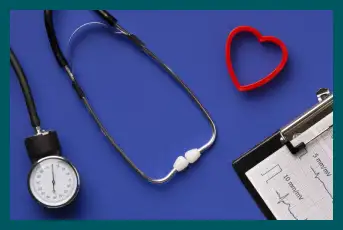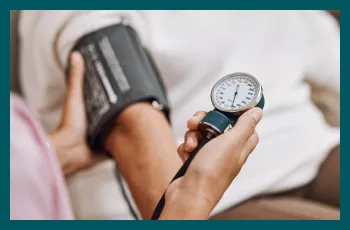How to Lower Blood Pressure Naturally?
Written by the editorial staff writer at Hola. Medically Reviewed by Dr Nelson Lau, MBBS FRACGP, GP & Digital Health Specialist. Dr. Ammar AL-ANI, MBChB, CCBST, AMC. Blog updated on 14 November, 2025. Originally published on 25 June, 2024.

Contents

Overview
Almost one in three adults in Australia suffers from high blood pressure1, and many remain unaware of it. Hypertension, or high blood pressure, raises the risk of heart disease, strokes, and kidney issues, yet it often develops gradually without noticeable symptoms. The positive aspect is that making simple changes to your lifestyle can lead to considerable benefits. By focusing on diet, physical activity, and stress management, you can take charge of your blood pressure and protect your heart health in the long term.Understanding high blood pressure
Blood pressure gauges the force of your blood against the walls of your arteries. It's measured in millimetres of mercury (mmHg) and represented with two figures, systolic (when the heart contracts) and diastolic (when the heart relaxes between beats).| Category | Systolic (mmHg) | Diastolic (mmHg) |
| Normal | Below 120 | Below 80 |
| Elevated | 120–129 | Below 80 |
| High blood pressure (Stage 1) | 130–139 | 80–89 |
| High blood pressure (Stage 2) | 140 or higher | 90 or higher |
Natural prevention tips
Reducing high blood pressure naturally doesn’t necessitate drastic changes; minor, consistent modifications to your everyday routine can yield lasting benefits.Eat a balanced, heart-healthy diet
A diet abundant in fresh fruits, vegetables, whole grains, nuts, and lean proteins fosters heart health and aids in lowering blood pressure. The DASH (Dietary Approaches to Stop Hypertension) plan has proven particularly effective. Minimise your intake of processed foods, salt, and saturated fats.Reduce salt intake
Australians typically consume more salt than is advised. Strive for less than 5 grams (approximately one teaspoon) daily. Read food labels, opt for “low-sodium” items, and enhance your meals with herbs or lemon juice rather than salt.Maintain a healthy weight
Even a slight weight reduction can decrease blood pressure. Concentrate on sustainable practices such as portion control, regular physical activity, and balanced eating rather than extreme dieting.Stay active
Engaging in regular physical activity strengthens your heart and boosts circulation. Aim for a minimum of 30 minutes of moderate exercise most days, such as brisk walking, cycling, or swimming.Limit alcohol and caffeine
Excessive intake of alcohol or caffeine can elevate blood pressure. Adhere to national guidelines, no more than 10 standard drinks per week spread over several days, and reduce coffee or energy drink consumption if you are sensitive to caffeine.Manage stress:
Chronic stress can lead to elevated blood pressure levels. Engage in relaxation methods such as deep breathing, mindfulness, yoga, or short outdoor walks. Allocating time for rest and hobbies also enhances emotional well-being.Quit smoking
Smoking harms blood vessels and hastens heart disease. If you smoke, seek assistance through resources like Quitline Australia or consult your GP for personalized cessation strategies.Get enough sleep
Inadequate sleep raises stress hormones and impacts blood pressure regulation. Strive for 7–9 hours of quality sleep each night by sticking to a consistent bedtime and reducing screen time before bedtime.Monitor your blood pressure regularly
Regular blood pressure monitoring is crucial for tracking your progress and noticing changes early.- Utilise a home blood pressure monitor for easy checks.
- Visit GP or local pharmacy for professional measurements.
- Check your blood pressure at least once every 6-12 months (more frequently if you have risk factors).
- Keep a record of your readings in a notebook or digital tracker to discern trends over time.
Feeling sick and unsure why? Speak with a GP online in 15 minutes.
When to see a doctor
Making lifestyle modifications can be very beneficial for many, but seeking professional help is essential if:- Your blood pressure regularly remains above 140/90 mmHg.
- You feel chest pain, dizziness, headaches, or shortness of breath.
- You suffer from other medical conditions, such as diabetes or heart disease.
How Hola Health can help
At Hola Health, you can receive convenient blood pressure assessments and personalised guidance by online GP. Our Australian GPs offer lifestyle recommendations, online prescriptions, and ongoing follow-up through secure telehealth appointments. Schedule a telehealth consultation today to obtain customised support for managing your blood pressure and enhancing your heart health.Conclusion
Lowering blood pressure naturally is achievable through regular exercise, a balanced diet, stress management, and reducing salt and alcohol intake. If your readings stay high despite these efforts, consult a GP. With Hola Health, you can easily access online doctor support for personalised heart health advice anytime.FAQs
What are some quick methods to lower blood pressure at home?
Consider practicing deep breathing, reducing your salt intake, maintaining proper hydration, and finding ways to manage stress. These techniques can help lower blood pressure levels temporarily.Can walking help lower blood pressure?
Absolutely. Consistent walking boosts heart health and improves blood circulation, which may help in naturally reducing blood pressure.What is considered a normal blood pressure range in Australia?
A normal blood pressure reading is considered to be below 120/80 mmHg, according to the Heart Foundation Australia.How long does it take to naturally lower blood pressure?
With consistent lifestyle adjustments, positive changes can be noticed within a few weeks to a few months.Will medication be necessary if I make lifestyle adjustments?
Not necessarily. Many individuals can manage mild hypertension through lifestyle changes alone; nevertheless, some may still need medication depending on their risk factors.How can I track my blood pressure at home?
Utilise a digital upper-arm blood pressure monitor, carefully follow the provided instructions, and record readings at the same time each day to ensure accuracy.Feeling sick and unsure why? Speak with a GP online in 15 minutes.
Reference
RPH research foundation - Reference linkWhat we treat
- Cough
- Nausea & vomiting
- Fever
- Hayfever
- Fatigue
- Sore throat
- Acne
- Hair loss
- Gout
- Eczema
- Rosacea
- Sunburn
- UTI
- Erectile dysfunction
- Contraception
- Morning sickness
- Morning after pill
- Prostate health
- Anxiety
- Depression
- Stress
- Grief & loss
- Antidepressants
- Premature ejaculation
- Asthma
- Blood pressure
- Blood thinners
- Diabetes
- Cholesterol
- Migraines & headaches
- Allergies
- Body ache
- Heartburn & reflux
- Sleep disorder
- Pain relief
- Gastro
Related Articles
Healthy Blood Pressure By Age: What Is Good Blood Pressure Based On Age?
Disclaimer
This blog is for general informational purposes only and does not indicate that Hola Health provides all treatments or preventive measures mentioned. It is not intended to be a substitute for professional medical advice. Always seek the guidance of your doctor or other qualified health professional with any questions you may have regarding your health or a medical condition. For emergencies please immediately contact 000. Any medical topics discussed are intended to educate, not to imply availability through Hola Health.
 Facebook
Facebook  X
X  Copy Link
Copy Link



